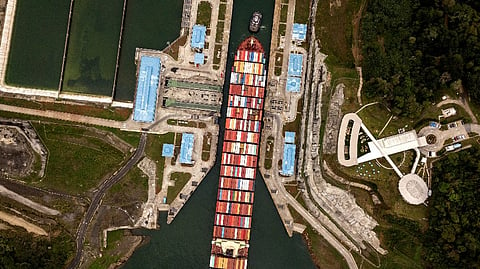

The Panama Canal expects an increase in transits of liquefied petroleum gas (LPG) vessels and carriers of some agricultural commodities to help it compensate for a reduction in world trade next year, the waterway's chief told Reuters on Monday.
The world's second-busiest interoceanic waterway registered a 14 per cent revenue increase to $5.7 billion in the fiscal year ended in September and saw 19 per cent more transits, with LPG vessels and container ships moving more cargoes through the canal that connects the Pacific and Atlantic oceans.
"LPG is a product that will be even more valuable in the next 20, 25 years," Ricaurte Vasquez, the administrator of the Panama Canal Authority, said on the sidelines of the Houston International Maritime Conference.
The imposition of US tariffs and trade policy changes pushed an increase in canal traffic, particularly in the third quarter of the year, with many shippers sending cargoes well ahead of the Christmas season to avoid more adverse measures.
The canal's share of US LPG exports to Asia has recovered to more than 95 per cent, from 80 per cent in 2023-2024, when a severe drought forced passage restrictions and triggered delays, Vasquez said.
The authority is seeking interest from companies in building a two-million-barrel-per-day LPG pipeline in the canal zone, to be inaugurated in 2030, which would help the waterway expand that market. Many US companies have shown interest, Vasquez said.
He also said there is a change in some grain flows, including Chinese purchases of soybeans, that could benefit the canal.
The authority is banking on the higher LPG and agricultural transits to offset its forecast for a revenue decline this fiscal year as less cargo is traded.
During that period, it expects total tonnage moving through the canal to fall by about 40 million tonnes from the 489 million tonnes moved in the previous fiscal year as some vessel categories, including LNG tankers, will use the canal less.
Earlier this month, the canal launched a competitive process to select companies to build and operate two new ports within the canal zone, hoping to have them ready in 2029. The pre-qualification process is expected to be completed early next year, Vasquez said during the conference.
In 2031, Panama could see the completion of the ambitious Rio Indio reservoir project to secure freshwater for the canal, which is progressing slowly, Vasquez said.
The reservoir is part of three key infrastructure projects that will collectively require $8.5 billion in investment in 10 years.
(Reporting by Marianna Parraga; Editing by Tom Hogue and Christian Schmollinger)
